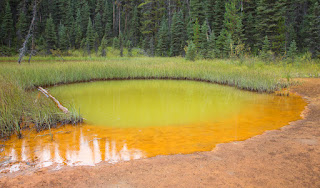Paint Pots and Marbel Canyon
At the beginning of September I was the photographer and local guide for a travel writer friend of mine from Europe. It is always fascinating to see the reaction of visitors to our close by wonders. One becomes aware again of the vast beauty around us.
Banff National Park was on top of our to see list. The plan was to wait for nice weather and then head up there. Unfortunately the conditions went from super smoky to overcast to rainy, and time was running out. We decided to ignore the weather and go anyway.
On the way to Banff lays Kootenay National Park. Although it does not have the majestic views of Banff and surroundings, it does have some gems that are well worth exploring.
First off there are the Paint Pots...
The 2013 flood washed out the suspension bridge over the Vermillion river, so the Paint Pots were not accessible until this summer. Now with a brand new bridge it is an easy and very colorful stroll.
After crossing the bridge wide ochre fields open up. As we were there the water had mostly drained and beautiful colored rocks covered the ground.
Various sediments deposited on the bottom of an ancient glacial lake became the clay at the Ochre Beds. The amazing colors result from the saturation of the clay with iron rich water. (2)
The locat Ktunaxa call the ochre beds " the place where the red earth spirit is taken" They "harvested" the ochre, then cleaned it and kneaded it with water into walnut sized balls. These ball got flattened into little cakes and baked. The baked cakes then were ground into a powder which they mixed with fish oil or animal grease to paint their bodies, tipis, clothing or pictures on the rocks.
The trail leads then from the Ochre Beds along a very brightly orange colored stream to its source, the actual springs which form the Paint Pots.
Walking up the trail one really can experience the clay nature of the ground...in other words: It's rather slippery! Supernatural colors though...
The trail ends at the Paint Pots. The smallest looks more like a big puddle but the two bigger ones are stunning.
The Paint Pots themselves are formed by the accumulation of iron oxide
around the outlets of three cold mineral springs. As the rim of iron
builds up around each pot, they gradually increase in height. The
greenish colour of the two larger pots is the result of the mixing of
fresh water from a small creek, which empties into the largest pool.(1)
In the early 1900s a mining company tried to exploit the Ochre Beds as a source for paint pigment. That undertaking failed relatively soon and the mine site was abandoned. Some of the equipment still sits there, slowly rusting away.
Continuing Hwy 93 towards Banff shows why wide parts of the Kootenay National Park are also called "Lightning Alley". In 2003 multiple big fires, caused by lightning, burned huge areas of the park and the remaining burned trunks are an impressive sight. They would be also an depressive sight, but the fresh green trees and plants, especially the bright purple fireweed, among them are showing the regenerative power of fire.
Historically forest fires are part of a natural cycle. After a wildfire, over a long period of time, the various stages of the post-fire habitat can support a much broader variety of species than the mature pre-fire forest did. Before these big 2003 fires, fires in the park got managed by trying to extinct them as soon as possible. But later on, as the positive effect of the wildfires became evident, the fire management strategy includes now a prescribed burn program. It is expected that by 2018 to 2023 the burned area will be prime grizzly bear and moose habitat.(3)
For now it seems it is prime fireweed habitat...
Fireweed is also abundant at the next stop, Marble Canyon.
It took Tokumm Creek, a glacially fed creek, approx. 8000 years to slowly but steady erode the surrounding dolomite bedrock into todays' canyon. Is it real marble? No, true marble would be metamorphic dolomite altered by heat and pressure. Although Marble Canyon is formed into dolomite rock it is not metamorphic. The silt laden glacial waters of the creek though smoothed the sides of the canyon to a marble like shine.
Multiple bridges span over the canyon and ...
...the views down to the rushing turquoise water are amazing but maybe not for the faint-hearted, as the canyon reaches a depth of almost 40 meters.
The 2003 fires also left their mark here at the canyons' surroundings.
A great example how live finds a way back and actually thrives after a fire. Who can spot the little spider?
After about 600m the beginning of the canyon is reached, a beautiful small waterfall.
There is one more place I want to check out along the Kootenay Park, the hike up to Stanley Glacier. Since the hike is know for it's spectacular wildflower display in July, it is on my agenda for next year!
For more information on hikes and guided tours in park please check out 10Adventures
(1) The History of the Paint Pots
(2) Canadian Rockies Explorer by Graeme Pole
(3) Kootenay National Park


























No comments:
Post a Comment